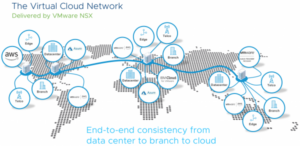
None of us know what the future holds. That’s why technology innovation is about turning the narrow into the wide; about keeping your options open; about covering all eventualities. Businesses know they need to be adaptable so that they can deal with the inevitability of the unexpected and embrace opportunity on the fly: they need more flexibility, lower costs, greater openness.
It takes a lot of pieces to complete this puzzle. Yet, of all the innovations ‘du jour’ – think robotics, automation, AR and VR, IoT – ‘networking’ is too often overlooked, even though it’s the medium through which everything else happens.
It’s also the one that offers real business potential for the partner community. Just as every organisation is different, every organisation’s network is different. Think of the consultancy and expertise required to optimise speed, security and scale, not to mention the configuration and implementation aspects, that come with transforming an entire network infrastructure.

But why are we talking about this now? It’s because organisations are demanding more from their networks today; they’re realising the stranglehold an outdated network can have on their agility, velocity and efficiency as their business struggles to transform. They’re doing so at a time when the concept of a transformed network – a Virtual Cloud Network, if you will – is set to radically change the networking game, by providing an evolutionary path to consistent, pervasive connectivity and security for apps and data, wherever they reside – from the data center, to the cloud, out to the branch and on to the edge. All these elements together add up to a fantastic opportunity for the channel to add real business value for their customers.
Context: today’s networking bottleneck
Until now, organisations have operated using Local (LAN) and largely physical Wide Area Networks (WAN) to carry data traffic over their local, campus and branch networks. These are related but fundamentally different technologies, optimised for very different purposes. LANs are typically cheap, commoditised, built to a well-established industry standard and in general, deliver fast, high-bandwidth within an immediate geographic area – i.e. within a building or small campus. Businesses have been virtualising these for a while, bringing all associated scalability, performance, management and security benefits – but only up to a point.
That point is the wide area network router that connects your LAN to a WAN – extending the network beyond just the building. Today, router technology is one of the last areas of infrastructure still largely dominated by hardware-oriented solutions, with the WAN itself normally still based on legacy technologies such as leased line frame relay and T1 connections. Organisations are effectively renting dedicated capacity on a shared network, where connectivity is fixed, through cables and leased lines that are expensive, slow and, crucially, offer only a limited capability to scale linearly and quickly as the business requires.
In a business world of constant change where most of your advantage comes from how much faster you can react to market opportunities than your competition, this can have huge implications. Say you’re a major bank with global operations, demanding zero downtime, colossal bandwidth to support millions of instantaneous transactions, and total resilience in every aspect of the business. You’re also under huge pressure to innovate your front-end in line with evolving customer demands. You might move to the public cloud or implement a hybrid cloud for greater flexibility and agility – to innovate at speed – which is fine in theory. However, without having similarly flexible enterprise-grade connectivity across your entire network (your LAN and your WAN), you’re only going to be as good as the slowest link in your networking chain. You’ve brought in all this great new technology but remain hampered by a networking bottleneck preventing you from realising all the benefits you’re pursuing.
The software-defined alternative
Here’s where the Virtual Cloud Network comes in. A Virtual Cloud Network is a network powered entirely by software: a secure, universal fabric into which any data centre, device, sensor or cloud can be plugged. It’s an entire network virtualised; no more compulsory hardware routers or leased lines, just turbo-charged end-to-end performance, with security built into the beating heart of it all, right out to the very edge of the network.
It enables any organisation to connect, secure, and optimise the delivery of applications and data in an era when an increasing number of workloads will exist outside the data centre. A Virtual Cloud Network can be applied across many vertical markets to improve performance. In healthcare, for example, it could ensure high performance for real-time applications such as voice and video for telemedicine and provide secure access to data for mobile healthcare. In retail, it could support increased customer engagement with in-venue technologies that have high bandwidth demands, ensuring connectivity for POS applications and electronic payment transactions.

Savvy organisations are already reaping the benefits. Take a European telco company, which deployed and activated its entire SD-WAN infrastructure in less than a week. By establishing SLAs over secure VPN connections between Europe and America, it was able to bring together locations in Berlin, Germany and Mountain View, California via an agile, responsive end-to-end network. This meant it could deploy advanced architectures supporting next generation industrial networking for robotic applications in a simplified, cost-effective manner, without a complete technology ‘rip and replace’.
The perfect storm for partners
The opportunity for partners lies in helping their customers to get all this right. If your customers aren’t already demanding better, cheaper, more flexible and reliable networking, then they soon will be – and if they don’t, they’re going to start losing out to their competitors, and quickly.
Networking is such an exciting element for the channel because it makes everything happen – and has become relevant to any partner that is having conversations with customers that are looking to digitally transform. A Virtual Cloud Network is the next logical step towards opening the door to IoT technologies and edge computing.
Building a Virtual Cloud Network requires technical expertise. It’s not necessarily about ripping out existing physical WAN connections, but instead about incorporating this software layer to sit alongside existing infrastructure, to support and optimise an evolutionary journey between today and tomorrow. This is the real opportunity for the channel: working with organisations to best deliver an evolutionary Virtual Cloud Network, ready to usher in the next wave of business transformation.

Alanzo Blackstock is the Director, Partner Organisation UK & Ireland for VMware. He is responsible for driving strategic alliances and managing VMware’s partner ecosystem within the region, by ensuring the company’s innovative solutions help its partners differentiate and drive profitability.
Having joined the business in January 2017, Alanzo has a track record of building strong relationships with partners in the region. He demonstrates passion and an ability to understand how partners can embrace new and innovative technologies to help their customers drive digital transformation efforts, whilst opening them up to new revenue opportunities.
Alanzo’s career extends over 25 years in the IT industry, and prior to this appointment, he was responsible for managing Cisco’s largest partners in the UK. Having worked with the company for over a decade, he has a wealth of experience in helping sell services to financial services, industrial, retail, telecoms and media companies with a focus on managed services, security, cloud services and mobility.


